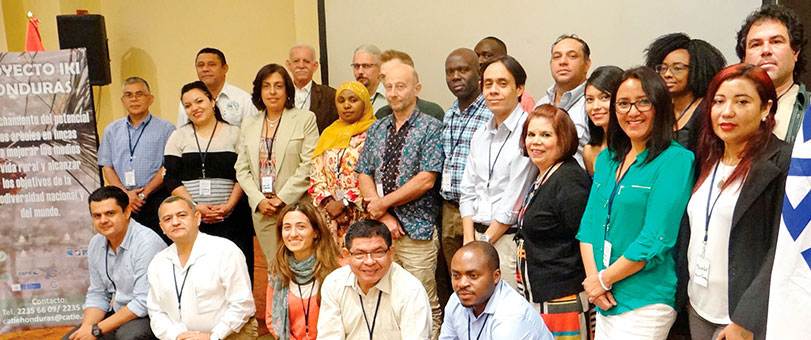- International experts met in Honduras to define tools to assess on-farm biodiversity conservation
November 23, 2018. Within the framework of the project Exploiting the Potential of Trees on Farms to Meet National and Global Biodiversity Targets implemented in Rwanda, Uganda, Indonesia, Peru and Honduras, more than 15 international experts are working to finalize a unified protocol that will serve to assess biodiversity on agricultural lands in the five countries mentioned above.
The project, known as Trees on Farm, is developed by a consortium that leads the International Centre for Research in Agroforestry (ICRAF) and comprises the Center for International Forestry Research (CIFOR), CATIE (Tropical Agricultural Research and Higher Education Center), the International Union for Conservation of Nature (IUCN), the University of Göttingen, the Leibniz University of Hannover and the University of Tanjungpura. Its main objective is to help countries include the contributions of on-farm trees in reports to the United Nations Convention on Biological Diversity.
In order to work on the definition of this protocol, from November 12 to the 16, international experts met in Honduras to hold a workshop in which more than 60 local actors and partners also participated.
During the opening of the workshop, ICRAF researcher Rhett Harrison presented the advances of the biodiversity protocol and, after several other presentations by experts, the three main components of the methodology were reviewed: inventory of trees on farms, bird monitoring and options for evaluating and monitoring other indicators.
On each of these components, the experts deliberated and gave their conclusions and recommendations, which will be considered in the development of the final version of the protocol
Eduardo Somarriba, leader of CATIE’s Agriculture, Livestock and Agroforestry Program, explained that the biodiversity assessment protocol and the Trees on Farm project, as such, seek to provide the Honduran government with a low-cost, easy-to-use monitoring tool, which should continue to be used to monitor trees and biodiversity on farms.
“The results obtained will help the government report to the United Nations Global Conventions on progress in biodiversity conservation, while involving farmers in the use of trees to increase sustainable production on their farms,” said Somarriba.
Mauricio Guevara, Minister of the Secretariat of Agriculture and Livestock (SAG, its Spanish acronym) of Honduras, spoke at the opening of the workshop on the potential to increase trees on farms and increase Honduras’ capacity to achieve biodiversity targets. He added that trees on farm can help farmers mitigate the consequences of climate events.
For her part, Anabel Gallardo, vice president of the National Federation of Agricultural and Livestock Producers of Honduras (FENAGH), spoke about the efforts that the federation is developing to promote more sustainable production systems, including the formation of the National Platform for Sustainable Livestock from where you can encourage the introduction of trees on farm.
Also, Francisco Aceituno, representative of the Directorate of Biodiversity of the Ministry of Environment and Natural Resources (DIBio-MiAmbiente, its Spanish acronym), stressed the importance of the project to define and monitor biodiversity indicators and said that the Directorate of Biodiversity is attentive to adopt the tools generated by the project, being this agency the focal point of the project in the country.
During the last days of the workshop, the experts visited the area of Catamacas, Olancho (one of the pilot sites of the project) with the objective of contextualizing what had been discussed so far and obtaining elements for the definition of the details of the methodology. In this site a cattle farm and another coffee producer were visited, two highly potential areas to integrate trees, where they interacted with the farmers and discussed the productive and environmental challenges and the possible solutions that should be adopted to face them.
Finally, in Catacamas, a meeting with local actors and authorities was also held at the National University of Agriculture (UNA, its Spanish acronym). At this meeting, Harrison presented the progress of the protocol for monitoring biodiversity on farms and the implications at the local level.
In this space, UNA shared experiences on the monitoring of big cats and their prey as biodiversity indicators; while the Institute of Forest Conservation (ICF, its Spanish acronym) showed the efforts in tree certification to encourage the increase of plant coverage in the area.
Somarriba emphasized on the important role of the UNA in developing studies to identify the best intervention options for producers and to generate evidence of the contribution of trees to biodiversity and rural household incomes.
This meeting was attended by more than 60 people, who showed interest in the topic of trees on farms and for participating in the studies and activities of the project.
More information:
Edwin Garcia
IKI-TonF- Project Honduras
egarcia@catie.ac.cr
Written by:
Karla Salazar Leiva
Communicator
Information Technology and Communication
CATIE
karla.salazar@catie.ac.cr

